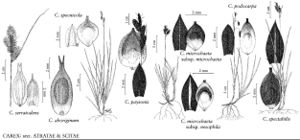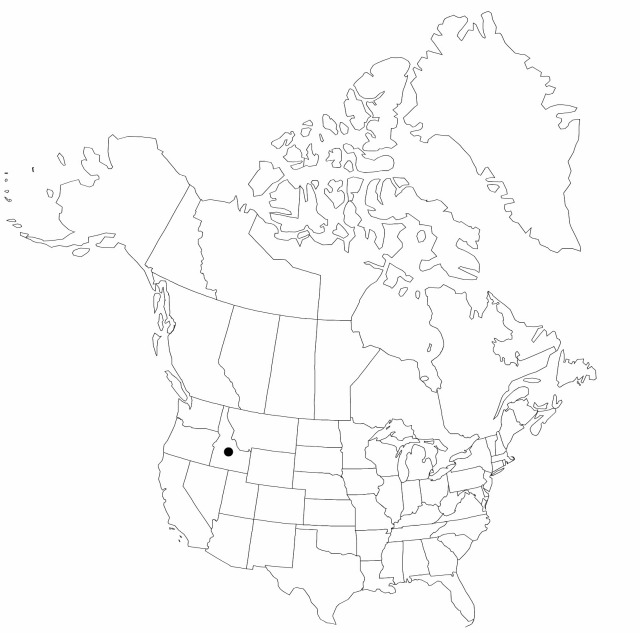Difference between revisions of "Carex aboriginum"
Biol. Ser. Bull. State Univ. Montana 15: 69. 1910.
FNA>Volume Importer |
FNA>Volume Importer |
||
| Line 24: | Line 24: | ||
|distribution=Idaho. | |distribution=Idaho. | ||
|discussion=<p>Of conservation concern.</p><!-- | |discussion=<p>Of conservation concern.</p><!-- | ||
| − | --><p>Carex aboriginum was not seen from the time of its original collection in 1899 until its rediscovery, in the vicinity of the type locality in 1999 (C. Bork 2000), and at a nearby site in 2000. The abundant new material matches the type specimens in all respects. On the basis of the type alone, F. J. Hermann (1970) considered C. aboriginum to be very close to C. serratodens, which the new specimens support. Carex aboriginum has pistillate spikes with perigynia clearly larger and staminate spikes on longer peduncles. These morphologic distinctions and the disjunct distribution of C. aboriginum from the main range of C. serratodens argue for provisionally maintaining it at the rank of species until sufficient specimens are available to permit a reëvaluation of variation. The illustration in K. K. Mackenzie (1940) as C. aboriginum is of another species.</p> | + | --><p><i>Carex aboriginum</i> was not seen from the time of its original collection in 1899 until its rediscovery, in the vicinity of the type locality in 1999 (C. Bork 2000), and at a nearby site in 2000. The abundant new material matches the type specimens in all respects. On the basis of the type alone, F. J. Hermann (1970) considered <i>C. aboriginum</i> to be very close to <i>C. serratodens</i>, which the new specimens support. <i>Carex aboriginum</i> has pistillate spikes with perigynia clearly larger and staminate spikes on longer peduncles. These morphologic distinctions and the disjunct distribution of <i>C. aboriginum</i> from the main range of <i>C. serratodens</i> argue for provisionally maintaining it at the rank of species until sufficient specimens are available to permit a reëvaluation of variation. The illustration in K. K. Mackenzie (1940) as <i>C. aboriginum</i> is of another species.</p> |
|tables= | |tables= | ||
|references= | |references= | ||
| Line 48: | Line 48: | ||
|publication year=1910 | |publication year=1910 | ||
|special status= | |special status= | ||
| − | |source xml=https://jpend@bitbucket.org/aafc-mbb/fna-data-curation.git/src/ | + | |source xml=https://jpend@bitbucket.org/aafc-mbb/fna-data-curation.git/src/8f726806613d60c220dc4493de13607dd3150896/coarse_grained_fna_xml/V23/V23_749.xml |
|genus=Carex | |genus=Carex | ||
|section=Carex sect. Racemosae | |section=Carex sect. Racemosae | ||
Revision as of 17:10, 18 September 2019
Plants cespitose. Culms 55–80 cm, distally slightly roughened. Leaves 3–4.5 mm wide. Inflorescences: peduncle of terminal spike 0.5–2 cm; proximal bracts shorter or longer than inflorescences; spikes erect, separate, pedunculate, short-oblong or elongate, 15–30 × 9–12 mm; lateral 1–3 spikes pistillate, of varying lengths, mostly shorter than terminal spike or of similar lengths; terminal spike gynecandrous or staminate, 8–25 mm. Pistillate scales lanceolate, shorter and narrower than perigynia, apex acute or mucronate, spinulose. Perygynia veined, broadly ovate, (4.7–)5–6.6 × 2.2–3.4 mm, distal margins serrulate, spinulose, apex gradually beaked; beak 0.5–1 mm, bidentate, teeth spreading, spinulose. Achenes nearly filling body of perigynia.
Phenology: Fruiting early May–Jun.
Habitat: On well-drained soils of seasonally wet stream banks
Elevation: 700–1000 m
Discussion
Of conservation concern.
Carex aboriginum was not seen from the time of its original collection in 1899 until its rediscovery, in the vicinity of the type locality in 1999 (C. Bork 2000), and at a nearby site in 2000. The abundant new material matches the type specimens in all respects. On the basis of the type alone, F. J. Hermann (1970) considered C. aboriginum to be very close to C. serratodens, which the new specimens support. Carex aboriginum has pistillate spikes with perigynia clearly larger and staminate spikes on longer peduncles. These morphologic distinctions and the disjunct distribution of C. aboriginum from the main range of C. serratodens argue for provisionally maintaining it at the rank of species until sufficient specimens are available to permit a reëvaluation of variation. The illustration in K. K. Mackenzie (1940) as C. aboriginum is of another species.
Selected References
None.

